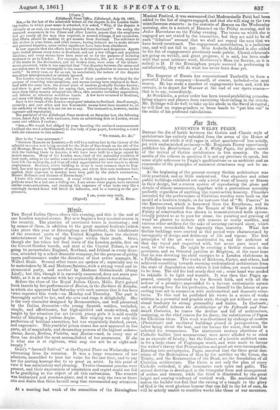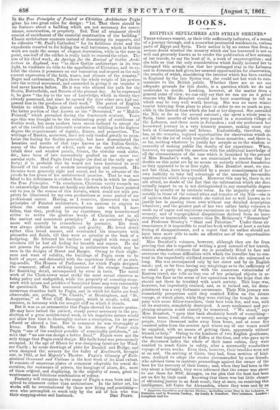hut 3rto.
AUGUSTUS WELBY PUGIN.
BEFORE the din of battle between the Gothic and Classic style of architecture has entirely subsided from the arena of the House of Commons, and while it still rages in other quarters—if less noisily, yet with undiminished acrimony—Mr. Benjamin Ferrey opportunely publishes his Recollections of A. N. Irelby Ptwin, the prime mover of the revival of Gothic architecture in this country. On the merits of the volume in question it is not my province to speak, but some slight reference to l'ugin's qualifications as an architect and an expounder of the principles of mediteval structures may not be un- timely. At the beginning of the present century Gothic architecture was little practised, and as little understood. Our churches and other public buildings exhibited not only a total want of beauty or fitness in their design, but a craven system of reproducing the plans and details of classic monuments, together with a pretentious unreality perfectly regardless of anything like constructive honesty. Churches intended for the performance of Christian worship were built on the model of a heathen temple, as for instance that of "St. Pancras" in the Euston-road, which is borrowed from the Ereetheum, and its steeple freely rendered from the Temple of the Winds at Athens. Falsity of construction was shown in cement-covered walls symme- trically jointed so as to pass for stone, the painting and graining of wood or plaster to imitate rich veneers or costly marbles, and various other artifices for the sake of securing outward show, which were more remarkable for ingenuity than sincerity. What few Gothic buildings were erected at this period were characterized by incongruity of design and deficiency of life and vigour. The first principles of the art were unattended to, and the architect of that day toyed and coquetted with, hut never gave heart and soul, to the work. He might be erecting a Gothic church in the provinces, and an Oriental pavilion at Brighton, at the same time that he.was devoting his chief energies to a London dub-house in a Palladian manner. The works of Rickman, Carter, and others, had achieved something towards rescuing ecclesiastical architecture from the state of degradation into which it had fallen, yet much remained to be done. The old fire had nearly died out ; some hand was needed to rekindle it to light and warmth. It was then that Pugin ap- peared, recently converted to the Romish faith, and with all the ardour of a proselyte superadded to a fervent enthusiastic nature and a strong love for his profession, set himself to the labour of pro- moting true art in connexion with ecclesiastical and domestic struc- tures. To this end he published his views in a series of works written in a powerful and graphic style, though not without an occa- sional tendency to strollg personality and italics. In Contrasts; or, a Parallel between the Architecture of the Fyleenth and Nine- teenth Centuries, he traces the decline and fall of architecture, assigning, as the chief reason for its decay, the substitution of Pagan for Christian ideas. This work was illustrated by etchings of modern (Protestant) and mediteval buildings placed in juxtaposition, the latter being about the best, and the former the worst, that could be selected for comparison. The nineteenth century abortions of a Catholic builder (not unuumerous) were never alluded to or cited as an example of fatuity; hut the failures of a heretic architect came in for a large share of Puginisque wrath, and were made to favour the writer's theory that Protestantism and good art were incompatible. Entering into metaphysics, Pugin asserted that the three great doc- trines of the Redemption of Man by the sacrifice on the Cross, the Trinity, and the Resurrection of the Dead, are the foundation of all Christian architecture. The Cross is not only the plan of every Catholic cathedral, it also terminates each spire and gable. The second doctrine is developed in the triangular form and arrangement of arches and tracery, while the third- is illustrated by the great height and soaring tendency of vertical work. He contended that unless the builder can feel that the raising of a temple to the glory of God is the most glorious honour that can fall to the lot of man, he will be utterly unable to conebive works like those of our ancestors. In the True Principles of Pointed or Christian Architecture Pugin gives his two great rules for design: "1st. That there should be no features about a building which are not necessary for conve- nience, construction, or propriety. 2nd. That all ornament should consist of enrichment of the essential construction of the building." Classic architecture conceals instead of decorating its supports, and he ridicules "St. Paul's Cathedral" for its fictitious dome and the expedients resorted to for hiding the wall buttresses, which in Gothic work are made the means of elegant decoration, while in the case in point, one-half of the edifice is really built to conceal the other. The aim of his third work, An Apology for the Revival of Gothic Archi- tecture in England, was "to show Gothic architecture in its true light, to vindicate its title to the appellation of Christian, and to ex- hibit the claims it possesses on our veneration and respect as the only correct expression of the faith, wants, and climate of the country." Eager and enthsi.siastic, Pugin threw the whole weight of his powers into the revival movement, and succeeded in giving it an impulse it had never known before. He it was who cleared the path for the Scotts, Butterfields, and Streets of the present day. As he expressed it, he gave "the key to the use of knowledge, which in theory they already possessed, and since he opened the door other men had sur- passed him in the goodness of their work." The period of English Gothic to which Pugin almost exclusively confined himself was the latter portion of that known as the "Decorated," or "Middle Pointed," which prevailed during the fourteenth century. Years ago this was thought to be the culminating point of excellence of Gothic work, but more modern taste seems inclined to accept the art of the twelfth and thirteenth centuries as fulfilling in the highest degree the requirements of dignity, fitness, and proportion. The writings of Ruskin, moreover, have not only tended greatly to popu- larize the feeling for Gothic generally, but have disseminated the beauties and merits of that type known as the Italian Gothic, many of the features of which, such as the spiral column, the inlaid door and window panels, friezes, the circular sunk niche, ac., have been of late successfully grafted on our more ver- nacular style. Had Pugin lived longer (he died at the early age of forty) it is probable that he would not have hesitated to avail himself of the results of modern investigation and research. His theories were generally right and sound, and far in advance of the proofs he has given of his architectural practice. That lie was not blind to his deficienees is evident from the words in which he closes the True Principles. "In conclusion, Christian verity compels me to acknowledge that there are hardly any defects which I have pointed out to you in the course of this lecture, which could not with pro- priety be illustrated by my own productions at some period of my professional career. Having, as I conceive, discovered the true principles of Pointed architecture, I am anxious to explain to others the errors and misconceptions into which I have fallen, that they, profiting by my experience, may henceforward strive to revive the glorious works of Christian art in all the ancient and consistent principles." As an architect Pug,in's name will scarcely be remembered by posterity. His work was always deficient in strength and gravity. tie loved detail rather than broad masses, and overloaded his structures with pinnacles and finials, till they were as spicular as the back of a hedgehog. He frittered his outlines and niggled with cusps and crockets till he lost all feeling for breadth and repose. He did not possess the painter-like feeling in architecture which may be seen in the designs of Street and Barges. Owing to their slight- ness and want of solidity, the buildings of Pugin seem to be built of paper, and decorated with the capricious frisks of an etch- ing-needle. The Houses of Parliament, tor which Pugin designed the ornament, afford a striking instance of his strange fondness for finnicking detail, accompanied, by error in taste. The metal work of the Clock-tower must strike the most casual observer as being paltry and undignified, while the propriety of mounting stone- work with spines and prickles of burnished brass may very reasonably be questioned. The most successful specimens amongst the very numerous churches built by Pugin, and in which his faults are least observable, are, perhaps, "St. Chadds," at Birmingham, and "St. Augustine," at West Cliff, Ramsgate, which is simple, solid, and massive, in harmony with the sea-girt cliff on which it stands.
But it was as an ornamentist that Pugin showed his innate genius. He may have lacked the patient, steady power necessary to the pro- duction of a great architectural work, or his impulsive nature would not allow him time to thoroughly mature a conception, for he never effaced or altered a line. But in ornament he was thoroughly at home. Even Mr. Ruskin, who in his Stones of Venice calls Pugin "one of the smallest possible of conceivable architects," ad- mits that "no one can design a better finial." Finials were not the only things that Pugin could design. His facile hand was precociously occupied. At the age of fifteen he was designing furniture for Wind- sor Castle ; he made drawings of plate for Rundell and Bridge, and even designed the; scenery for the ballet of Kenilworth, brought out, in 1531, at her Majesty's Theatre. Pugin's Glossary of Eccle- siastical Ornament and Costume is the best work of its kind extant. It consists of nurnerous plates of ornament adaptable for mural de- coration, the vestments of priests, the hangings of altars, &c., most of them original, and displaying, in the majority of cases, great in- ventiveness and felicitous combination of colour.
Posterity will recognize in the name of Pugin a man born and in- spired to ornament rather than architecture. In the latter art, his works will be overshadowed by those now living and practising— men who accomplish so much only by the aid of him who was
their stepping-stone and landmark. DINT Ponr.































 Previous page
Previous page